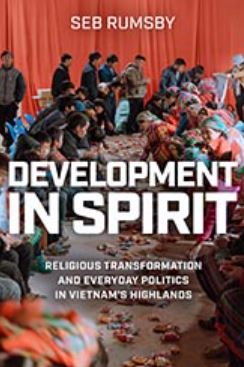To rescue Vinh from its ruins, East Germany provided substantial material and technological assistance that was designed to transform it into Vietnam’s model socialist city. However, this transformation was not without its challenges, as Vinh’s rapid ascendance was followed by a quick fall into ‘unplanned obsolescence’, writes Xue Xuan, reviewing Building Socialism: The Afterlife of East German Architecture in Urban Vietnam by Christina Schwenkel
_______________________________________________
In her book Building Socialism: The Afterlife of East German Architecture in Urban Vietnam, Christina Schwenkel tells of the neglected story of the Vietnamese city Vinh’s socialist reconstruction during the Cold War. This city was badly decimated by U.S air strikes between 1964 and 1973. To rescue Vinh from its ruins, East Germany provided substantial material and technological assistance that was designed to transform it into Vietnam’s model socialist city. However, this transformation was not without its challenges, as Vinh’s rapid ascendance was followed by a quick fall into ‘unplanned obsolescence’.
Schwenkel skillfully weaves historical records with ethnographic research to dissect the architectural forms and planning practices of postwar Vinh, while also capturing its residents’ lived experiences within this changing urban landscape. This historical ethnography of Vinh’s postwar reconstruction offers an in-depth exploration of state-led socialist modernization, its vision, implementation, and subsequent impact. During the Cold War, information about these urban experiments among socialist countries was largely inaccessible and unknown to the external world. To expose these facts contributes to a better understanding of socialist modernization. It also resonates with the “multiplicity of experienced modernities”, thereby shifting the focus away from the dominant narrative of capitalist spatial production.
Interestingly, the book does not dedicate a specific section to explain what socialist urbanism is. Instead, its unique characteristics are gradually revealed across several chapters through detailed documentation of historical events and objects. Schwenkel contends that socialist planning was both a “utopian science” and a “fantastical art of projection”, often venturing into realms of impracticality. She examines two visual devices in the service of modernist planning: figurative drawing and abstract blueprints, delving deep into how these visual renderings of rationalized spaces sought to represent a universal socialist future. However, when materialized in buildings and infrastructures, the rational planning was far from fulfilling its promise: it neither increased labor productivity nor molded enlightened proletarians. The author employs the case of Quang Trung Housing Estate to concretize how practical problems like poor material conditions and conflicting spatial practices inhibited the rapid construction of mass housing and how residents’ uncivil behaviors serves to contest quotidian forms of urban governance, epitomizing the dialectical relationship between civilization and backwardness. The ethnographic approach of this study offers the author an opportunity to deliver a nuanced understanding of the lived experiences associated with socialist urbanization. This perspective underlines the agency of citizens, challenging prevailing views that often portray citizens as passive participants. Schwenkel traces manifold ways that residents in Quang Trung made the decayed buildings adapt to their changing needs and urban lifestyles. Such acts, as demonstrated in the book, were not arbitrary but planned, which serves as individualized ways to pursue the unfinished utopia.
A particularly fascinating aspect of Schwenkel’s analysis is the focus on affect. She skillfully draws together socialist planning and its afterlife in mass housing through the thread of affect, generating many thought-provoking ideas. When recounting the destruction of Vinh during the war with the United States, Schwenkel pays particular attention to the contrasting visual techniques employed by U.S. and Vietnam in reporting and recording urban warfare. In contrast with the aerial photographs by the U.S. military, those photos taken by Vietnamese photographers employ close-up shots in recording the architectural remains of everyday urban life. The intimate portraits of the destroyed buildings powerfully convey the sense of trauma perceived by the people. This sense of trauma further strengthened international solidarity between East Germany and Vietnam, as detailed in the chapter “Solidarity”. It also set the stage for East Germany’s involvement in Vinh’s postwar reconstruction, which is thoroughly explored in the chapter “Spirited Internationalism”. This international solidarity, as demonstrated in the book, was both political and affective, appearing on the surface as a form of brotherhood between East Germany and Vietnam, but at its core, it was characterized by an asymmetrical relationship. The middle part of the book elaborates how this international solidarity gave birth to socialist planning and architectural forms in Vinh. The author delves into the complexities of international solidarity as affective practice, highlighting the challenge of cultural differences, misaligned expectations, and the difficult balance between altruism and self-interest. The last part of the book features voices from the people of Vinh, who inhabited and used modernist architecture. Their affective attachments to the modernist architecture of the city are reflected in the various modifications they made to their residences, which subverts the narrow understanding of seeing modernist architecture as the product of rationality. To examine this state-sponsored, nationalist project through the thread of affect is very intriguing. It also piques my curiosity: how affect relates specifically to socialist urbanization as opposed to capitalist urbanization? While the author briefly addresses this aspect in certain chapters, a detailed exploration is not provided.
The book’s strength lies in its methodological approach. Schwenkel’s transnational perspective, underpinned by extensive use of both German archives and Vietnamese sources, allows for a nuanced understanding of this complex historical interplay. By engaging with key informants in Vinh and delving into local archives, Schwenkel brings to the fore voices that have long been marginalized in historical discourse.
In conclusion, “Building Socialism” is a compelling read for scholars and enthusiasts of socialist urban planning and architecture, Asian urbanization, and postcolonial studies. The book offers a comprehensive and nuanced understanding of the socialist modernization in the postwar city of Vinh. It not only sheds light on a lesser-known chapter of Cold War history but also propels readers to think about the lasting impact of architectural and urban planning decisions in the shaping of societal narratives and experiences.
______________________________________________
* This book review is published by the LSE Southeast Asia blog and LSE Review of Books blog as part of a collaborative series focusing on timely and important social science books from and about Southeast Asia.
* Banner photo front cover of Building Socialism: The Afterlife of East German Architecture in Urban Vietnam by Christina Schwenkel.
*The views expressed in the blog are those of the author alone. They do not reflect the position of the Saw Swee Hock Southeast Asia Centre, nor that of the London School of Economics and Political Science.





